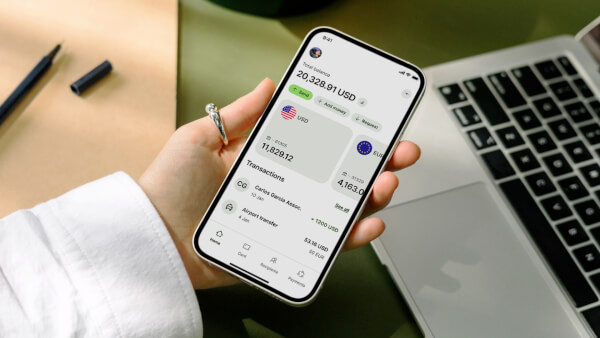Oxygen Business Account Review & Alternatives
Oxygen Business Account review will cover all you need to decide if it's the best choice for your business!

There are two different ways for your company to sell on Amazon. You can sign up as a seller to offer your products on the Amazon platform or be invited to be an Amazon vendor. Both have pros and cons.
In this article, we’ll discuss the Amazon vendor vs seller topic, including the pros and cons of each, to help you decide which is best for your business.
Receive Amazon Payments with
Wise Business
Amazon sellers can market their products to over three hundred million users on the e-commerce giant’s retail platform.¹ It’s the direct-to-consumer option when comparing seller vs vendor on Amazon. If you want to wholesale your products to Amazon for resale, you must be part of the Amazon Vendor program. We’ll explain both options below.
Members of the Amazon Vendor program are wholesale suppliers to Amazon. This is not something you can “sign up” for. Your company can express interest in becoming a seller, but Amazon needs to select you. Reach out to your Amazon rep to get the application you need to request an invitation.
One of the best arguments for Amazon Vendor Central vs Amazon Seller Central is that inventory management and customer fulfillment are taken out of your hands. Amazon sets the price it charges consumers. Your company is a wholesaler. You can negotiate what Amazon pays you, but you cannot control what they charge others.
An Amazon seller is a company or individual that sells its products directly to consumers on the Amazon retail platform. This model is more common than the vendor model because you don’t need an invitation to be a seller. Simply go to their seller page, watch the videos, read the information, and click the “Sign Up” button to get started.
It costs $39.99 a month plus selling fees to be a part of Amazon Seller Central for the professional subscription, or $0.99 per item sold for the individual subscription.² We’ll compare Amazon Seller vs Vendor Central fees in our “Key Differences” section below. Pay close attention to marketing fees and margins. Sellers are expected to cover their marketing fees and run their campaigns. Vendors can pay Amazon to do that for them.
| Feature | Amazon Vendor | Amazon Seller |
|---|---|---|
| Pricing Control | Amazon sets the price | You set the price |
| Inventory Management | Amazon fulfillment centers | In-house |
| Payments and Fees | Customers pay Amazon | Customers pay you |
| Relationship with Amazon | You are a wholesaler | You are a retailer |
The chart above shows a simple side-by-side comparison of Amazon Vendor Central vs Seller Central. This section provides a more detailed explanation of the categories covered in that chart.
Amazon sellers control their pricing. Amazon vendors don’t. This is a simple wholesale vs retail scenario. A wholesaler sells their product to a retailer for a discounted price. The retailer then marks it up to make a profit. Amazon vendors are wholesalers. Amazon sellers are retailers, so they get to set the prices they charge their customers.
Amazon manages the inventory in the Amazon Vendor program. They evaluate what they need and send purchase orders to your company. Products are then delivered to Amazon’s fulfillment centers, and organized for sale to consumers. This is one of the primary benefits of vendor vs seller Amazon offers to its partners.
A key point of comparison is seller vs vendor Amazon fees. Payments from customers go to the party acting as the retailer.
Make sure to include that when calculating the margins of being a wholesaler.
Amazon sellers are retailers selling their products directly to consumers on the Amazon retail platform. The difference between Amazon seller vs vendor is that vendors wholesale their products to Amazon. The responsibility for fulfilling orders transfers to Amazon in that arrangement. Your company will receive purchase orders for what they need.
The pros and cons of your relationship with Amazon depend upon your company's economic situation and needs. One example is your profit margin. If your company can handle a lower margin in return for steady business, Amazon Vendor is a pro. If not, it becomes a con, and Amazon Seller is a pro. Each of the points we made above can be viewed this way.
Your margin isn’t the only factor to consider when choosing between Amazon Vendor and Amazon Seller. You’ll also need to review your business goals, need for brand control, and financial situation.
Your choice could turn into a long-term business relationship, so it’s important to evaluate all aspects carefully before deciding which is best for you.
A vendor or seller relationship should be based on your business's needs and goals. If you want to sell various products directly to consumers, you’ll want to become an Amazon Seller. If you have one or just a few products and want to sell to one large client, the Amazon Vendor relationship is likely a better fit for you.
Your brand is your identity. Do you want to surrender control of that to Amazon? As a vendor, you’ll have no say in pricing or marketing strategies, while as a seller, you retain control of those elements. This is an important decision, and it depends on how much your brand is used in marketing your company. Speak to your Amazon representative about this.
Reducing your profit margins to become a wholesaler has financial implications. This is a good place to create a spreadsheet to evaluate projected revenue and expenses for Amazon Seller vs Amazon Vendor. Make sure you include marketing fees, shipping costs, and margin for returns and refunds. Treat the process as a budget exercise.
Does your company want to sell its products on the Amazon retail platform that reaches over 300 million people? Would you prefer that Amazon does the selling for you? Answer those questions first to start the Seller vs Vendor Amazon inquiry. Follow that up with a financial analysis and a review of your business goals. Use that data to make your decision.
Once you decide on the structure that’s best for your business, you’ll also need to choose how to receive your funds from Amazon. The good news is that Wise is an Amazon payment partner in the United States, United Kingdom, Europe, and Australia. Wise charges no monthly fee, does international payments at mid-market rates, offers easy batch payments, and connects to QuickBooks to track bill payments.
Most importantly, Wise is designed to manage multiple currencies all in one place. You can receive payments in multiple currencies, directly into your Wise account, avoiding high currency conversion fees. This is critical when wholesaling or selling on the Amazon platform because they are a global entity.
Sources:
Sources checked April 2024.
*Please see terms of use and product availability for your region or visit Wise fees and pricing for the most up to date pricing and fee information.
This publication is provided for general information purposes and does not constitute legal, tax or other professional advice from Wise Payments Limited or its subsidiaries and its affiliates, and it is not intended as a substitute for obtaining advice from a financial advisor or any other professional.
We make no representations, warranties or guarantees, whether expressed or implied, that the content in the publication is accurate, complete or up to date.

Oxygen Business Account review will cover all you need to decide if it's the best choice for your business!

Navigating the intricate legal terrain of international royalties can be daunting for musicians, often leading to earnings sitting unclaimed. In fact, the...

This guide to employee benefits in France will cover all you need to stay compliant and provide the best additional benefits to attract talent.

This Santander Business Checking review will cover all you need to decide if it's the best choice for your business!

Getting paid is a key moment for your business - it means that your product fit and marketing strategy has hit the mark and customers are happy to exchange...

This guide to employee benefits in Germany will cover all you need to stay compliant and provide the best additional benefits to attract talent.